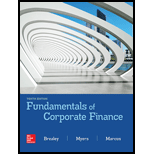
a.
To compute:
a.
Explanation of Solution
The formula to calculate return on equity is as follows:
Return on equity=Net income(shareholders equity at the end of the year+share holders equity at thestart of the year2)
The calculation of return on equity is as follows:
Return on equity =1223(9724+91212)=0.129796=13%
Hence, the ROE is 13%
b.
To compute:
b.
Explanation of Solution
The formula to calculate return on asset is as follows:
Return on asset=Net income+Interest expense(1−Tax rate)(Total assets at the start of the year+Total assets at the end of the year2)
The calculation of return on capital is as follows:
Return on assets=1,223+685×(1−.35)(27,714+27,5032)=0.0604=6.04%
Hence, the ROA is 6.04%
c.
To compute: Return on capital (ROC)
c.
Explanation of Solution
The formula to calculate return on capital is as follows:
Return on capital=Net income+Interest expense×(1−Tax rate)([Long term debt and leases at the start of the year +shareholders equity at the end of the year]+[Long term debt and leases at the end of theyear+shareholders equity at the end of theyear]2)
The calculation of return on equity is as follows:
Return on capital=1,223+685×(1−.35)[(7,018+9,724)+(6,833+9,121)]2=0.1020=10.20%
Hence, the ROC is 10.20%
d.
To compute: Days in inventory.
d.
Explanation of Solution
The formula to calculate days in inventory is as follows:
Days in inventory=Inventory in the start of the year(Cost of goods sold365)
.
The calculation of days in inventory is as follows:
Days in inventory==238(4,060365)=21.40 days
Hence, the days in inventory is 21.40 days
e.
To compute: Inventory turn over
e.
Explanation of Solution
The formula to calculate inventory turnover is as follows:
Inventory turnover=Cost of goods soldInventory at start of year
The calculation of inventory turnover is as follows:
Inventory turnover==4,060(187+238)2=19.11
Hence, the inventory turnover is 19.11
f.
To compute: Average collection period(ACP)
f.
Explanation of Solution
The formula to calculate average collection period is as follows:
Average collection period =Receivables at start of yearAverage daily sales
The calculation of average collection period is as follows:
Average collection period=2,490(13,193365)=68.89 days
Hence, the ACP is 68.89 days.
g.
To compute: Operating profit margin (OPM)
g.
Explanation of Solution
The formula to calculate operating profit margin is as follows:
Operating profit margin==Net income + After-tax interestSales
The calculation of operating profit margin is as follows:
Operating profit margin=1,223+685×(1−.35)13,193=0.1264=12.64%
Hence, the OPM is 12.64%
h.
To compute: Long term debt ratio
h.
Explanation of Solution
The formula to calculate operating profit margin is as follows:
Long term debt ratio=Long term debt and leases at the end of the year(long term debt and leases at the end of the year +shareholders equity at the end of the year)
The calculation of long term debt ratio is as follows:
Long-term debt ratio=7,0187,018+9,724=0.42
Hence the long term debt ratio is 0.42
i.
To compute: Total debt ratio
i.
Explanation of Solution
The formula to calculate total debt ratio is as follows:
Total debt ratio=(Total current liabilities at the end of the year+Long term debt and leases at the end of the year+Other long term liabilities at the end of the yearTotal assets at the end of the year)
The calculation of total debt ratio is as follows:
Total debt ratio=4,794+7,018+6,17827,714=0.65
Hence the total debt ratio is 0.65
j.
To compute: Times interest earned
j.
Explanation of Solution
The formula to calculate times interest earned is as follows:
Times interest earned=EBITInterest expense
The calculation of times interest earned is as follows:
Times interest earned=2,566685=3.75
Hence the time interest earned is 3.75
k.
To compute: Cash coverage ratio
k.
Explanation of Solution
The formula to calculate cash coverage ratio is as follows:
Cash coverage ratio=(EBIT+Depreciation)Interest expense
The calculation of cash coverage ratio is as follows:
Cash coverage ratio==2,566+2,518685=7.42
Hence the cash coverage ratio is 7.42
l.
To compute: Current ratio
l.
Explanation of Solution
The formula to calculate current ratio is as follows:
Current ratio=Current assetsCurrent liabilities
The calculation of current ratio is as follows:
Current ratio=3,5254,794=0.74
Hence the current ratio is 0.74
m.
To compute: Quick ratio
m.
Explanation of Solution
The formula to calculate quick ratio is as follows:
Quick ratio=Cash + Marketable securities + ReceivablesCurrent liabilities
The calculation of quick ratio is as follows:
Quick ratio=89+2,3824,794=0.52
Hence the quick ratio is 0.52
Want to see more full solutions like this?
Chapter 4 Solutions
Fundamentals of Corporate Finance
- critically discuss the hockey stick model of a start-up financing. In your response, explain the model and discibe its three main stages, highlighting the key characteristics of each stage in terms of growth, risk, and funding expectations.arrow_forwardSolve this problem please .arrow_forwardSolve this finance question.arrow_forward
- solve this question.Pat and Chris have identical interest-bearing bank accounts that pay them $15 interest per year. Pat leaves the $15 in the account each year, while Chris takes the $15 home to a jar and never spends any of it. After five years, who has more money?arrow_forwardWhat is corporate finance? explain all thingsarrow_forwardSolve this finance problem.arrow_forward
 Essentials Of InvestmentsFinanceISBN:9781260013924Author:Bodie, Zvi, Kane, Alex, MARCUS, Alan J.Publisher:Mcgraw-hill Education,
Essentials Of InvestmentsFinanceISBN:9781260013924Author:Bodie, Zvi, Kane, Alex, MARCUS, Alan J.Publisher:Mcgraw-hill Education,

 Foundations Of FinanceFinanceISBN:9780134897264Author:KEOWN, Arthur J., Martin, John D., PETTY, J. WilliamPublisher:Pearson,
Foundations Of FinanceFinanceISBN:9780134897264Author:KEOWN, Arthur J., Martin, John D., PETTY, J. WilliamPublisher:Pearson, Fundamentals of Financial Management (MindTap Cou...FinanceISBN:9781337395250Author:Eugene F. Brigham, Joel F. HoustonPublisher:Cengage Learning
Fundamentals of Financial Management (MindTap Cou...FinanceISBN:9781337395250Author:Eugene F. Brigham, Joel F. HoustonPublisher:Cengage Learning Corporate Finance (The Mcgraw-hill/Irwin Series i...FinanceISBN:9780077861759Author:Stephen A. Ross Franco Modigliani Professor of Financial Economics Professor, Randolph W Westerfield Robert R. Dockson Deans Chair in Bus. Admin., Jeffrey Jaffe, Bradford D Jordan ProfessorPublisher:McGraw-Hill Education
Corporate Finance (The Mcgraw-hill/Irwin Series i...FinanceISBN:9780077861759Author:Stephen A. Ross Franco Modigliani Professor of Financial Economics Professor, Randolph W Westerfield Robert R. Dockson Deans Chair in Bus. Admin., Jeffrey Jaffe, Bradford D Jordan ProfessorPublisher:McGraw-Hill Education





